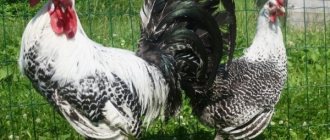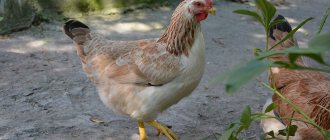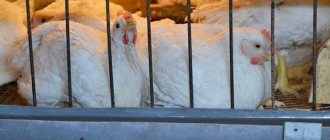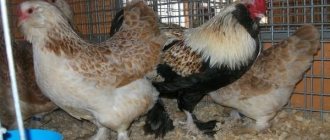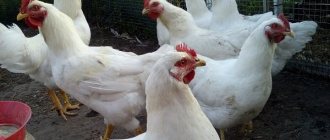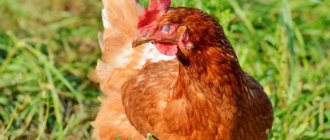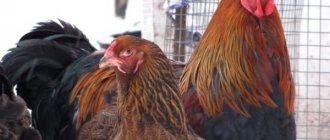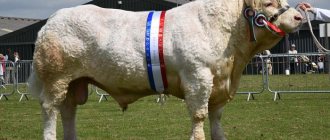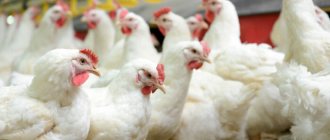1 626
no comments yet
0
Author:
Rasskazov Pavel.
Reading time: 4 minutes
Broilers are a type of cross of the chicken family, which was obtained by breeders by repeatedly crossing certain lines of chickens. Broilers are not a breed. They retain their characteristics only in the first generation.
Features and differences between broilers and regular chickens
Broilers differ from regular chickens in the presence of the following characteristics:
- the body weight of a cross-country chicken is much greater than that of ordinary chickens of the same age;
- short legs and wings;
- calm balanced character;
- increased feed consumption per head;
- rapid growth.
Weight gain
Peak weight growth in cross chickens occurs in the first 1.5 weeks. During this time, the young animals gain 1.3-1.5 kg. By the second month, the bird weighs from 1.8 to 2 kg. By 3-3.5 months, chickens reach 2.5 kg or more.
Body structure
The appearance of the birds is also somewhat different from the appearance of ordinary chickens:
- externally the bird looks squat;
- short wings, powerful short legs, yellow , widely spaced;
- the chest is fleshy , protruded forward;
- thighs are powerful and muscular;
- the plumage is predominantly white without unnecessary inclusions;
- light skin.
The ability to breed offspring and transfer productive data
Broiler chickens lack the brooding instinct. Chickens are hatched in incubators.
Expert opinion
Sadchikov Nikolay Alekseevich
Veterinarian ornithologist
Ask a Question
It is not advisable to obtain offspring from broilers: the young animals do not retain their exceptional characteristics characteristic of this type of cross. Offspring are bred only from certain lines of purebred chickens.
Arrangement of the place
Before moving broiler chickens into the chicken coop, you will have to prepare the room. To do this you will need to do the following:
- It is good to disinfect the poultry house. To do this, it is necessary to plaster and cover the walls with lime, and also cover the floor with lime in a ratio of 1 kg per 1 m2.
- Seal all cracks and cracks in the walls to avoid drafts. You should not cover the holes with old rags and other unnecessary things; it is better to plaster them thoroughly.
- Cover the floor with a soft covering 10-12 cm thick. For this you can use straw or small sawdust.
- Install vertical and frontal drinkers and feeders. In this case, the length of the containers must be calculated in such a way that there is no crowding during meals.
- Equip perches. The size of each should be 30-35 cm. The gaps between the perches can be made the same length.
If it is necessary to build a new chicken coop, it is worth considering the standards adopted for raising broiler chickens. It is better to use wood as the main building material. But plywood and cinder block are allowed. The ceiling height should be 1.8-2 m. To protect the livestock from the penetration of small animals, you will need to raise the foundation by 35-40 cm.
What breeds of chickens are used to breed broilers?
For the selection of broilers, meat and meat-egg chickens are used. The most popular of them are Cornish and Plymouthrock. Crossing with Brahma, New Hampshire, Langshan is possible.
For example, crosses are obtained by crossing white Cornish roosters, which pass on meat qualities to the offspring, with meat-egg hens, mainly with the white Plymouth Rock line. The resulting chickens are crossed again with white Cornishes. The result of this selection is broilers.
Origin of broiler chicken
Broilers have been bred for many years. Breeding is dominated by meat or meat and egg products of this breed. Crossbreeding allows you to obtain individuals of increased mass. In them, mature chicks gain enormous mass up to 6 months. With such a short lifespan, they are ready for slaughter.
The original crossbreeding was from the Cornish paternal side and the White Plymouthrock on the maternal side. Selective breeding has been practiced since 1930 and reached its peak in 1960. But development did not stop there. Cattle breeding programs included the Fighting Cornish, New Hampshire, Langshans and Jersey Giant chicken breeds. As a result, the chickens acquired a strong genetic line of meat. They can be used in households or in large-scale production.
Broiler chickens are the latest hybrid. The bird consists of several lines of different species, tested for compatibility.
Broiler crosses
Popular broilers in the Russian Federation are considered:
Cross refers to the meat direction, characteristics, content
Broiler Ross 308
Early maturing cross with high rates of meat productivity and egg production
Broiler Ross 708
Bohemian meat chickens with exuberant growth. Main characteristics, nuances of content
Broiler Cobb 500
Early maturing broilers of Dutch selection with good meat productivity and calm disposition
Broiler Gibro-6
Domestic meat and egg cross with minimal maintenance and feeding costs
Broiler-61
Compact, early maturing chickens with a universal focus that do not require large areas for keeping
Broiler-M
An early maturing cross of universal orientation, perfectly adapted to Russian conditions
Broiler Shift
An extra-heavy meat hybrid that will generate income without any maintenance difficulties
Broiler Cobb 700
Chick care
In order for broiler chickens to grow healthy, they must be carefully looked after. Basic care activities include:
- Treating the chicken coop with disinfectant solutions before moving in the young animals. For these purposes, products such as Ecosept or Arquadez are suitable. To prepare the solution, add 250 ml of disinfectant to 1 liter of water. The advantage of such disinfection is that there is no need to rinse off the solution.
- Daily cleaning of feeders and water bowls. It is also necessary to ensure that food and liquids in containers are always fresh. Do not allow food to become sour or rotten. It is best to feed the chicks little by little and add fresh food as the feeders empty.
- Ensuring plenty of drinking water. Broiler chickens drink a lot. The feeling of thirst leads to significant psychological discomfort and reduces the productivity of the bird.
- Adding potassium permanganate to water. This event is held once a week to disinfect the stomachs of young animals. To prepare the solution, just add a little potassium permanganate to the drinking bowls until the liquid turns pale pink. The prepared solution should be in the drinking bowls for no longer than 40 minutes. After this time, you will need to replace it with clean water.
- Organization of a special disinfection mat - a depression in the floor near the entrance filled with sawdust soaked in a disinfectant solution. Thanks to such a mat, chickens entering the chicken coop after a walk, as well as poultry farmers, will not be able to bring pathogens inside.
- Regular cleaning of the inside of the chicken coop. Excessive indoor pollution leads to various diseases and even death of birds. Therefore, once a week it is necessary to carry out general cleaning - remove droppings and change the bedding. And once a month, the walls and floor of the poultry house need to be treated with lime.
- Organization of "bathing" smoking. To clean the feathers, you need to install a large container with fine sand in the chicken coop. In it, the young animals will carry out hygiene procedures. In addition, ingesting small grains of sand helps improve the functioning of the gastrointestinal tract.
When performing the above activities, broiler chickens will feel as comfortable as possible. Therefore, it is worth making efforts to ensure sanitary conditions in the chicken coop.
Breeding process
To raise a bird, a number of steps are taken:
- purchase a hatching egg for hatching in an incubator or buy chickens aged from 1 to 3 days at a poultry farm or grown young animals with a maximum age difference of 5 days;
- determine the method of keeping livestock : cage or floor;
- purchase the necessary equipment - feeders, drinking bowls;
- stock up on feed according to age category;
- set the lighting and ventilation mode in the room.
Advice from experienced poultry breeders
Here are some useful tips from professionals who know everything about raising broilers:
- The feeding front increases as the population grows. This is done to eliminate competition for food.
- Broilers should eat the amount of food they receive within 30 minutes. If after half an hour there is food left in the feeders, the next time the portion is reduced.
- It is recommended to give broilers dry granulated feed from a month onwards. They are better digestible and chickens grow faster on them.
- For large livestock it is more convenient to use automatic drinkers that do not require maintenance.
Following these tips will help you avoid some mistakes in raising and keeping broiler chickens.
Content Features
Chicks and adult broilers are kept both in cages and on the floor. In both cases, it is necessary to observe planting density, temperature and light conditions, humidity and nutritional characteristics for each age period.
Chicken crosses: how do they differ from breed and hybrid?
Read
Is it possible to keep chickens in SNT, a private house, a city, or a country house?
Answer
Why do chickens peck each other until they bleed and what to do about it?
Causes of pecking
Chicken coop - location, materials
When planning to place a chicken coop on your site, it is important to remember that chickens cannot tolerate:
- low temperature,
- high humidity,
- lack of oxygen.
Choose a place with a groundwater level no higher than 1 meter from the ground surface.
- Floor. The concrete base is poured. The floor level is made 20-30 cm above the ground level. Such a base will avoid problems with humidity and prevent gas exchange with the ground. The entrance to the broiler chicken coop is preferably located from the east.
- The walls are usually made of treated wood, brick or blocks, and the blocks are plastered. When breeding at home, wooden chicken coops are often built. Insulation, such as polystyrene, is placed between two layers of boards. The walls should be smooth on the inside - this will make cleaning easier and allow for thorough disinfection.
- Roof. A solid or gable roof is made of wood, PVC or tiles. Sheet metal is less suitable for a roof; it gets very hot in the summer and cools down quickly in the winter. A gutter is installed under the roof.
Nutrition
Crosses are fed with balanced feed, aimed at meat chickens from the first days of life. From 1 to 3 weeks they are fed with PK-5 Start and Growth compound feed, from 4-5 weeks before slaughter - with Finish 1 compound feed. Together with dry food, you can feed mash and chopped vegetables.
- Stern
- Recipes
- Supplements
Compound feed pk-1
Description of food for egg breeds. Instructions for feeding laying hens
Read
Compound feed pk-2 and pk-3
Mineral and vitamin compositions, feeding standards
Read
Compound feed pk-4
Used to feed laying hens aged 15-17 weeks
Read
Compound feed pk-5
Composition and instructions for feeding broiler chickens
Read
Purina® Pro
Important differences from the previous line, application patterns Start, Growth, Finish
Read
Barley and wheat for laying hens
Germination and steaming of barley and wheat for chickens: how to do it correctly and how to give it to laying hens
Read
Wheat for broilers
Rules for feeding broiler chickens with wheat. Dosage for chickens from the second day of life and adult birds
Read
Mash
Making mash for broilers at home
Read
Rice and buckwheat
How and in what form you can use rice and buckwheat to feed chickens. Standards for adult birds and chickens
Read
Bread
What kind of bread can you feed chickens and how to do it correctly
Read
Fish
The product is given in limited quantities: overfeeding can cause serious harm to the bird
Read
Chalk
Chalk as a food additive for chicken feed. Feeding standards for chickens, young animals and laying hens
Read
Meat and bone meal
Meat and bone meal is a mandatory additive for feeding chickens, containing protein and fats of animal origin.
Read
Fish fat
How to give fish oil to chickens, layers and broilers. What are the benefits of the drug and are there any contraindications?
Read
Limestone
Limestone (dolomite) flour in the diet of chickens. Advantage over chalk and feed shell
Read
Salt
Daily dosage of salt for adult birds and young animals and cases of unwanted use
Read
Recommendations for raising broilers at home
If you want to get a good chicken carcass in a short time, follow these recommendations:
- When using an incubator, in the first ten days, organize the most comfortable conditions for the chicks and provide healthy, nutritious food.
- If you buy day-old chicks, carefully select each individual so that you can raise them at home in the future. Give preference only to the most active ones - this guarantees a reduced percentage of loss of young animals.
- In the first five days, give only dry seeds and ground grain. Avoid wet and fatty foods, such as cottage cheese. Such food is considered ideal for the proliferation of pathogenic flora, which leads to the death of broilers.
- When the young animals are one week old, switch them to a starter combination feed. The grain mixture contains balanced vitamins that support the health and growth of fast-growing individuals. Gradually add chopped fresh herbs. Don't forget to rinse it with boiled water first.
- From day 21, introduce vegetables, trimmings of meat and fish, and porridge cooked in broth into your diet. During this period, it is also advisable to give fermented milk products.
- Remember to maintain a comfortable temperature and humidity. Change the bedding material in a timely manner so that it does not have time to become wet. Excessive humidity develops specific diseases in birds.
Stern
Broilers are chickens that need optimally balanced feed. This is especially important in the first days of a chicken’s life. In the first week of life, the chick is exposed to stress, since its body is almost unadapted to the environment. That is why the use of prestarter feed is recommended. This food contains wheat, soybean meal, table salt, corn, premium quality fishmeal, synthetic amino acids, enzymes, a mixture of organic acids, monocalcium phosphate, antioxidants, limestone grains and a vitamin and mineral complex.
This entire mixture is an easily digestible feed, making it easier to keep.
Jersey giant
Jersey giants appeared in the USA. This is an artificially bred breed, the purpose of which was to replace the classic American turkey.
Although this did not happen, it still occupied an important place in the world of poultry farming
Purebred Jersey Giants weigh about 5-5.8 kg. But this breed grows much slower than other broilers. They require more time and food, which is not the best indicator for commercial production.
It is for this reason that Jersky giants are not grown on an industrial scale. However, it is a highly sought after bird in the backyard.
Chickens by nature are very calm and obedient, but roosters often show aggression. In addition to a large yield of meat products, this breed produces a decent amount of large eggs. This suggests that the breed is universal (dual purpose) and can be used for both meat and eggs.
Weight (rooster) – 5.8 kg
Weight (chicken) – 5 kg
Growth period – 16-21 weeks
Disadvantage: very slow growth
How to properly introduce compound feed?
Broiler chickens quickly adapt to new products. Therefore, they can be given compound feed already in the first week of life. Chicks require a special pre-start composition. At first, the feed is introduced in small quantities, and by the end of the week it completely replaces the egg.
After this, the chickens are gradually transferred to starter mixtures. The majority of the diet of one-month-old broilers consists of grain-based feed. Before slaughter, the birds are transferred to a finishing feed mixture.
For breeders who combine the breeding of broilers with the cultivation of various feed crops, it is more profitable to use their own raw materials than to buy ready-made mixtures. However, in this case there is a possibility of nutritional deficiency in the chickens' diet. To compensate for it, it is advisable to use special feed additives that contain proteins, vitamins, minerals, and enzymes in concentrated form.
